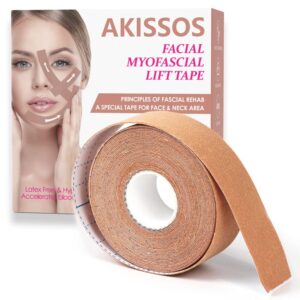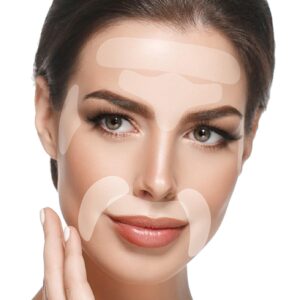Face Taping is an effective beauty technique that has taken over social media. It smoothes out wrinkles temporarily and lifts sagging skin. The method involves applying cosmetic tape on the areas of the face with prominent wrinkles and lines. The skin becomes tightened looking wrinkle-free and youthful. As the concept is trending on social media, it’s crucial to understand what face-taping can and cannot do before following this trend.
Skip To: Home Remedies for Wrinkles: How to Get Rid of Them?
How does Face Taping Work? The Science Behind It:
Face taping typically works by lifting the skin upwards or sideways. The skin has an immediate connection to the muscles on the face, and when the tape is used properly, it lifts the skin and enables nutrients and oxygen to flow beneath, reducing puffiness and smoothing lines. This tape also relaxes the muscles, and when applied overnight, the lymphatic system works harder, so you can expect to wake up with more vibrant, contoured skin.
The idea is based on mechanical stress applied to the skin. The tapes temporarily hide fine lines and wrinkles by tugging on the skin. However, the effects are primarily cosmetic. These tapes do not affect the structure or makeup of the skin, so when removed, it returns to its natural form. There’s no scientific evidence that face taping offers a long-term solution to skin aging or wrinkle reduction. It is a cosmetic fix rather than a long-term remedy.
Benefits and Potential Hazards:
Pros
- Instant Skin Tightening: Face lift tape provides an immediate lifting effect, helping to smooth out wrinkles and fine lines. It’s a quick solution for achieving a more youthful appearance without the need for invasive procedures.
- Non-Invasive and Cost-Effective: Unlike surgical face lifts, face lift tape offers a non-invasive alternative that is both affordable and easy to use. It’s a great option for those looking to enhance their facial contours temporarily without committing to expensive surgeries.
Cons
- Skin Irritation and Discomfort: Prolonged use of face lift tape can lead to skin irritation, redness, or discomfort, especially for those with sensitive skin. It may also cause issues with adhesive residue, which can be difficult to remove without irritating the skin further.
- Temporary Results: The effects of face lift tape are short-lived and typically last only for a few hours. This means it’s not a long-term solution for those seeking lasting changes in their facial appearance.
Best Face Tapes Available in Germany


Does Face Taping Remove Wrinkles?
Face taping can make skin appear smoother and wrinkle-free, but this effect is temporary. The skin regains its real appearance after the tape is removed. Further, improper use of tape results in more wrinkles and fine lines. The method prioritizes instant gratification over long-term growth.
Face Taping: A step-by-step Guide
Applying Face Tape
To get the greatest results, use these steps when applying face tape:
- Determine which parts of the face require lifting and tightening.
- Cut the face tape to the desired length and shape for each region.
- Cleanse and dry the skin to improve adherence.
- Gently apply the tape to the targeted location, ensuring it sticks well.
- Secure the tape using your fingertips.
- Repeat the technique for the other areas as needed.
- Don’t stretch the tape too firmly as it will hurt the skin.
Removing Face Tape
When removing face tape, follow these guidelines:
- To reduce irritation, gently take off the tape in the direction of hair development.
- Cleanse your skin afterward to remove any residue.
- Avoid applying harsh chemicals or tugging the tape too hard to avoid skin discomfort.
The Final Takeaway
Face taping is a faster and non-invasive way to get a temporary lift and smooth out wrinkles. However, it is hazardous for sensitive or allergy-prone skin. Before adding face tape to your cosmetic routine, always perform a patch test and check with a dermatologist. Finally, while face taping can be a fun and effective technique for short-term beauty enhancement, it does not replace long-term maintenance and healthy behaviors.




